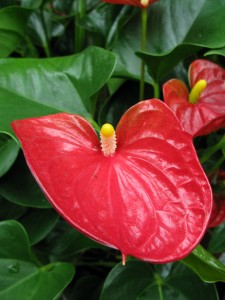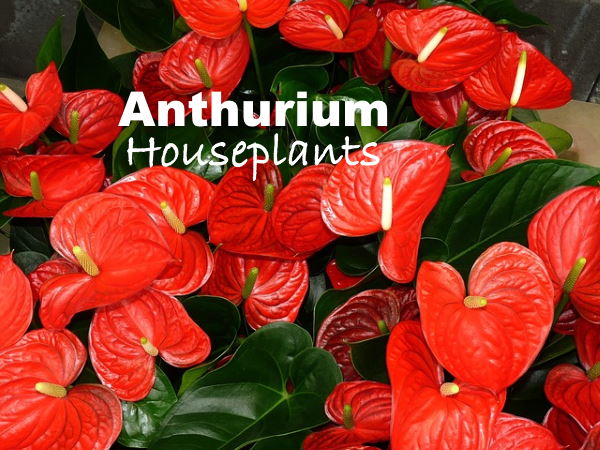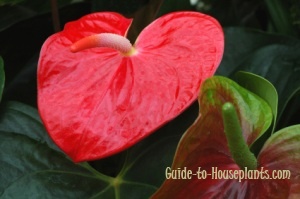Anthurium Plant Care – How to Grow Anthurium andraeanum Indoors
Botanical Name: Anthurium andraeanum
Anthurium plant is among the best-known tropical flowers. Popular in tropical flower arrangements, Anthurium bouquets are often used in weddings on Hawaii and other Pacific islands.

Anthurium andreanum, also known as tail flower, is especially colorful from spring through fall. Anthurium flowers are long-lasting, and newer cultivars will bloom almost year-round.
The glossy red, heart-shaped flowers are actually spathes that last for several weeks, each with a white spadix covered densely with its tiny, true flowers. Some varieties have spathe colors that are pink, orange-red or white.
Long, dark-green leathery leaves grow up to 8-in (20 cm) long, held on upright stems. Anthurium leaves are poisonous. They contain calcium oxalate crystals that cause severe burning in the mouth. Keep the plant away from pets who may play with or chew on its foliage. It’s also a good idea to wear gloves when handling this plant to avoid skin irritation.
Anthurium is a Keeper
Anthurium is a perennial that will live for several years with good care. What’s more, you can divide older plants for an ongoing collection (see “Propagation” below).

Caring for Anthurium Plants as Houseplants
Raise the humidity. Because of the need for humidity, Anthurium growing can be challenging in the home. However, newer cultivars are less fussy than the species. If the relative humidity drops below 50%, use a humidity tray or room humidifier to increase the moisture in the air. Grouping plants also helps to maintain the humidity around them. Brown leaf tips may be a sign of dry air.
To repot…or not. The best time to repot your Anthurium plant is when new growth begins in spring. Move into a pot that’s only 1-2 inches (2.5-5 cm) bigger — and only when necessary. Set the plant high so that the crown sits above the soil line. If roots show up at the surface between repottings, cover them with potting mix. Use a pot with drainage holes to prevent soggy soil; good drainage is essential.
Keep it clean. Anthurium leaves are naturally glossy. Just wipe them with a damp cloth to keep them dust-free. Avoid leaving water drops on the leaves because it may cause brown spots, a fungus that needs to be treated with a fungicide.
Yellow leaves are typically a symptom over-watering, but may be caused by cold drafts. This South American native wants warmth, year-round.
Something bugging your plant? Spider mites may invade Anthurium in the winter, if the air is dry. Watch for webbing between the leaves and stems, usually the first tell-tale sign of an invasion. Treat any infestation immediately. Fungus gnats are attracted to wet, peaty potting mixes; they’re easier to get rid of.
Anthurium Plant Care Tips

Origin: Columbia
Height: Up to 18 in (45 cm); compact cultivars reach only 12 in (30 cm). Tall flower stems may need staking.
Light: Bright light will make these beauties bloom. Give your plant as much bright light as you can year-round (at least 4 hours of bright light each day), but keep it out of direct sun. A curtain-filtered sunny window is ideal.
Water: Keep soil evenly moist spring through fall, slightly drier in winter. Yellow leaves are often caused by overwatering. Water thoroughly, but don’t allow soil to get soggy.
Humidity: This South American rain forest native craves high humidity year-round. Try to maintain 50% relative humidity or higher. Here are some easy ways to increase humidity for your tropical houseplants.
Temperature: (65-80°F/18-27°C) Anthurium plant prefers steady warm temps, just like we do. Protect it from cold blasts from doorways, windows and A/C vents.
Soil: Peat moss based potting mix with added perlite for good drainage; African violet potting mix is ideal.
Fertilizer: Feed every 2 weeks in spring and summer with a high-phosphorus water-soluble fertilizer.
Propagation: Divide crowded clumps when repotting. When a plant grows a new crown near the main plant, gently pull it away and plant it separately in a small container, keeping the crown of the plant above the soil line. New plants should bloom in about a year.




